 The American Revolution (1775-1783) was a conflict between the United Kingdom of Great Britain and its thirteen colonies on the east coast of North America. Following its victory over France in 1763, Great Britain had become the first colonial power in the world. In the New World, once the threat of a French invasion had passed, the loyalty of the thirteen American colonies to the British Crown was badly shaken. The imposition of taxes and restrictions on overseas trade sparked a movement of rebellion against European power. In 1776, the thirteen colonies proclaimed their independence. There followed a war which in 1783 resulted in the foundation of the United States of America .
The American Revolution (1775-1783) was a conflict between the United Kingdom of Great Britain and its thirteen colonies on the east coast of North America. Following its victory over France in 1763, Great Britain had become the first colonial power in the world. In the New World, once the threat of a French invasion had passed, the loyalty of the thirteen American colonies to the British Crown was badly shaken. The imposition of taxes and restrictions on overseas trade sparked a movement of rebellion against European power. In 1776, the thirteen colonies proclaimed their independence. There followed a war which in 1783 resulted in the foundation of the United States of America .
At the origins of the American Revolution
For most Britons, the colonies were first and foremost to serve England's commercial interests. They provided raw materials at lower cost for domestic industries, while providing an export outlet for its products. During the 18th century, Britain imposed laws restricting trade:American colonies with other countries, which had no other effect than to encourage clandestine trade with the Spanish, French and Dutch West Indies. During the Franco-Indian War, New England merchants began chartering their own vessels to export goods to Europe.
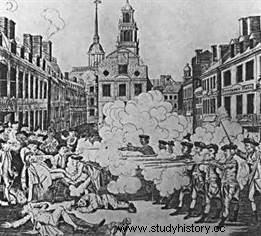 Once peace was ratified, however, the British government tightened customs controls to put an end to these activities, measures that only stoked resentment In addition, the large colonial landowners of the South feared that the anti-slavery movement, which was gaining ground in Britain, would disrupt the economy centered on the plantations.
Once peace was ratified, however, the British government tightened customs controls to put an end to these activities, measures that only stoked resentment In addition, the large colonial landowners of the South feared that the anti-slavery movement, which was gaining ground in Britain, would disrupt the economy centered on the plantations.
The Proclamation provision that in 1763 prohibited settlers from settling west of the Appalachians was added to the list of grievances. It aimed to avoid clashes with the Indians, whom the newcomers drove from their lands towards the interior of the continent. However, the uninterrupted flow of immigrants and the overpopulation of the colonies of the littoral imposed an irresistible pressure on the western borders. So many settlers simply ignored the law.
American settlers opposed to British taxes
The Seven Years' War having considerably strained its budget, the British government decided to bail out at the expense of the colonies. The Stamp Act imposed a tax on newspapers and official documents. This law aroused the indignation of American settlers, who had never before had to pay tax contributions. They boycotted British goods, while representatives of the thirteen colonies met to organize opposition. Under the slogan “No to taxes without representation”, they refused to pay the tax stamp, arguing that they had no voice in the British Parliament.
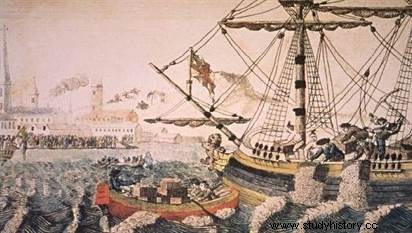 Quickly abandoned, the Stamp Act was almost immediately replaced by levies on tea, glass, lead, paint and paper. Here again, the government gave in to the boycott:it renounced all these contributions, except the tax on tea. The protests became more and more vehement, even violent. In 1770, British soldiers killed five demonstrators during a riot in Boston, an episode that went down in history as the “Boston Massacre”. These outbursts further fueled the settlers' resentment against Great Britain.
Quickly abandoned, the Stamp Act was almost immediately replaced by levies on tea, glass, lead, paint and paper. Here again, the government gave in to the boycott:it renounced all these contributions, except the tax on tea. The protests became more and more vehement, even violent. In 1770, British soldiers killed five demonstrators during a riot in Boston, an episode that went down in history as the “Boston Massacre”. These outbursts further fueled the settlers' resentment against Great Britain.
In December 1773 came the “Boston Tea Party”, an action led by a group of Boston citizens to protest tea taxes. The British retaliated with several retaliatory measures, known as “intolerable laws”, which rallied all the colonies against the crown. Some called for an immediate break with the colonial power, while others considered sedition only as a last resort. In September 1774, the Continental Congress met in Philadelphia to discuss the future of the colonies.
The American Revolutionary War
Congress does not seek a break with the United Kingdom, but tries to define the rights of the colonies of America, to set the limits of the power of Parliament, and to s agree on tactics to resist coercive laws. Before Congress could decide; fighting had already broken out. The skirmishes between rebels and British troops in Lexington and Concord in April 1775 degenerated into a general uprising.
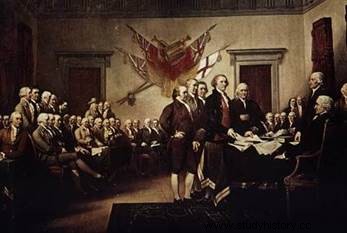 The Second Continental Congress met in Philadelphia on May 10, 1775 in a spirit of increased resistance. The delegates decide to make Congress the central government of the "United Colonies of America", to accept that the troops engaged in the siege of Boston become the "American Continental Army" and to appoint, by a unanimous vote on June 15 , George Washington Commander-in-Chief.
The Second Continental Congress met in Philadelphia on May 10, 1775 in a spirit of increased resistance. The delegates decide to make Congress the central government of the "United Colonies of America", to accept that the troops engaged in the siege of Boston become the "American Continental Army" and to appoint, by a unanimous vote on June 15 , George Washington Commander-in-Chief.
The idea of independence gained massive popular support following the publication, in January 1776, of Thomas Paine's Common Sense pamphlet. This pamphlet, published anonymously, attacks George III by calling him a "royal brute" and condemns the monarchical regime. Paine's arguments are decisive. On July 4, 1776, the Second Continental Congress proclaimed the Declaration of Independence. The divorce with the metropolis is definitively consummated:it is the beginning of the American Revolution.
In December 1776, George Washington's troops crossed the Delaware, then frozen, to attempt a daring attack on the Trenton garrison. The situation then began to elude the English.
France's decisive intervention
The year 1777 marks the turning point of the war in favor of the American cause. France, beaten by the United Kingdom in 1763, secretly sends money and supplies to the colonists since the beginning of the conflict. Thus, in the summer of 1777, the young Marquis de La Fayette, with a troop of volunteers equipped at his own expense, came to the aid of the insurgents.
 After having fought in Virginia, La Fayette returned temporarily to France, and supported Benjamin Franklin in his negotiation to obtain the official support from France. Convinced of the solidity of the American cause thanks to the victory of the insurgents at Saratoga, King Louis XVI, who recognized the independence of the British colonies in America on December 17, 1777, signed two treaties on the following February 6:the first was a treaty of friendship and commerce; the second provides for the alliance of the two nations in the event of a declaration of war by the United Kingdom against France. The decisive aid from France takes the form of the sending of arms, soldiers, warships and important subsidies.
After having fought in Virginia, La Fayette returned temporarily to France, and supported Benjamin Franklin in his negotiation to obtain the official support from France. Convinced of the solidity of the American cause thanks to the victory of the insurgents at Saratoga, King Louis XVI, who recognized the independence of the British colonies in America on December 17, 1777, signed two treaties on the following February 6:the first was a treaty of friendship and commerce; the second provides for the alliance of the two nations in the event of a declaration of war by the United Kingdom against France. The decisive aid from France takes the form of the sending of arms, soldiers, warships and important subsidies.
In June 1778, France officially entered the war on the side of the separatists against England. On August 14, 1781, George Washington learned that the Comte de Grasse was bringing the French fleet to Chesapeake Bay. He immediately decides to attack Cornwallis at Yorktown (Virginia). Washington's and Rochambeau's men and artillery headed south at a forced march, while leaving a troop to observe Clinton in New York. De Grasse's fleet arrived at the entrance to Chesapeake Bay on August 30, put to flight a British fleet commanded by Admiral Thomas Graves and established a blockade around Cornwallis' army. Under Washington's command, some 16,000 American and French soldiers, accompanied by militiamen from Virginia, laid siege to Yorktown. Cornwallis tried several times to force the Allied lines, but he had to surrender on October 19, 1781.
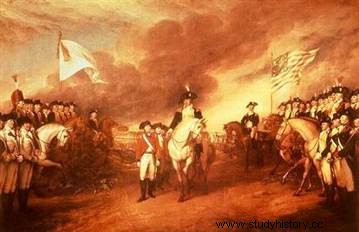 The Battle of Yorktown marks the end of hostilities. In early March 1782, the House of Commons authorized the opening of negotiations with the insurgents. The Anglo-American negotiations lead to the signing of a preliminary treaty, on November 30, 1782, in which the United Kingdom recognizes the total independence of its former colonies, and even abandons to them all its territories south of the Great Lakes until in Mississippi. The peace negotiations ended with the Treaty of Paris between the British and the Americans on September 3, 1783, then with the Treaty of Versailles between the United Kingdom and the other belligerents. France obtains colonial concessions, as does Spain, which receives Florida. Americans wishing to remain British subjects left for Canada, Crown territory.
The Battle of Yorktown marks the end of hostilities. In early March 1782, the House of Commons authorized the opening of negotiations with the insurgents. The Anglo-American negotiations lead to the signing of a preliminary treaty, on November 30, 1782, in which the United Kingdom recognizes the total independence of its former colonies, and even abandons to them all its territories south of the Great Lakes until in Mississippi. The peace negotiations ended with the Treaty of Paris between the British and the Americans on September 3, 1783, then with the Treaty of Versailles between the United Kingdom and the other belligerents. France obtains colonial concessions, as does Spain, which receives Florida. Americans wishing to remain British subjects left for Canada, Crown territory.
The drawing of the borders of the new United States of America determined during these treaties is a source of discord between the French and the Americans. They are defined as follows:the Sainte-Croix River, the watershed line between the St. Lawrence and the Atlantic Ocean, the 45th parallel, the middle of the Great Lakes, the Mississippi and the 31st parallel.
The Making of the United States Constitution
As soon as the war ended, the debate began on the organization of the United States government. In 1786-1787, the convention responsible for formulating the Constitution met in Philadelphia. Among the delegates, the “Fathers of the Constitution,” were Benjamin Franklin, John Adams, and George Washington.
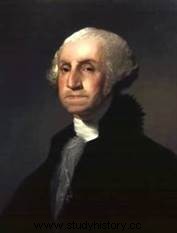 The delegates worked out a system of “checks and balances”, intended to prevent one of the powers accumulating too much influence over others. The executive rests with the head of state, the president, who does not have the power to legislate. The latter remains the prerogative of the two chambers (legislative power), whose members are also elected. Independent of the legislative and executive powers, the Supreme Court (judicial power) is responsible for interpreting the law. The American Basic Law was one of the first written constitutions of the 18th century. The Bill of Rights defines the rights of citizens and places specific limits on the power of government over them.
The delegates worked out a system of “checks and balances”, intended to prevent one of the powers accumulating too much influence over others. The executive rests with the head of state, the president, who does not have the power to legislate. The latter remains the prerogative of the two chambers (legislative power), whose members are also elected. Independent of the legislative and executive powers, the Supreme Court (judicial power) is responsible for interpreting the law. The American Basic Law was one of the first written constitutions of the 18th century. The Bill of Rights defines the rights of citizens and places specific limits on the power of government over them.
The thirteen British colonies were then the first to gain their independence from their European metropolis, and were the first country to adopt a written Constitution. However, the acquired political independence did not call into question the privileged economic and commercial relations with the British Crown.
Beginnings of Union expansion
Ratified in 1788, the Constitution took effect in 1799 and George Washington was elected the first President of the United States. In 1790, Rhode Island was the last of the Thirteen Colonies to join the Union. The latter quickly continued its territorial expansion westward, along the Ohio, and integrated Kentucky in 1792, soon followed by Tennessee and two other states. In 1800, ceded by Spain, the Mississippi basin fell back into the hands of France. In 1803, Napoleon, forced to bail out to finance his campaigns in Europe, sold the entire territory to the United States, the purchase of Louisiana practically doubling the area of the young republic. The conquest of the west could begin...
Bibliography
- The American Revolution, by Bernard Cottret. Tempus, 2004.
- The American Revolution:(1763-1789), by André Kaspi. Folio History, 2013.
